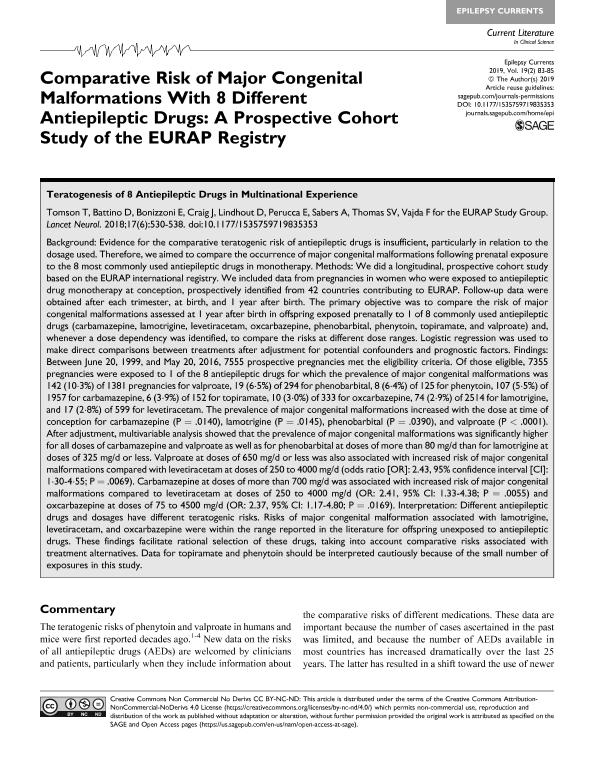Artículo
Comparative risk of major congenital malformations with eight different antiepileptic drugs: a prospective cohort study of the EURAP registry
Tomson, Torbjörn; Battino, Dina; Bonizzoni, Erminio; Craig, John; Lindhout, Dick; Perucca, Emilio; Sabers, Anne; Thomas, Sanjeev V; Vajda, Frank; Kochen, Sara Silvia ; Bohorquez Morera, Natalia
; Bohorquez Morera, Natalia
 ; Bohorquez Morera, Natalia
; Bohorquez Morera, Natalia
Fecha de publicación:
06/2018
Editorial:
Elsevier Science Inc
Revista:
Lancet Neurology
ISSN:
1474-4422
Idioma:
Inglés
Tipo de recurso:
Artículo publicado
Clasificación temática:
Resumen
Background: Evidence for the comparative teratogenic risk of antiepileptic drugs is insufficient, particularly in relation to the dosage used. Therefore, we aimed to compare the occurrence of major congenital malformations following prenatal exposure to the eight most commonly used antiepileptic drugs in monotherapy. Methods: We did a longitudinal, prospective cohort study based on the EURAP international registry. We included data from pregnancies in women who were exposed to antiepileptic drug monotherapy at conception, prospectively identified from 42 countries contributing to EURAP. Follow-up data were obtained after each trimester, at birth, and 1 year after birth. The primary objective was to compare the risk of major congenital malformations assessed at 1 year after birth in offspring exposed prenatally to one of eight commonly used antiepileptic drugs (carbamazepine, lamotrigine, levetiracetam, oxcarbazepine, phenobarbital, phenytoin, topiramate, and valproate) and, whenever a dose dependency was identified, to compare the risks at different dose ranges. Logistic regression was used to make direct comparisons between treatments after adjustment for potential confounders and prognostic factors. Findings: Between June 20, 1999, and May 20, 2016, 7555 prospective pregnancies met the eligibility criteria. Of those eligible, 7355 pregnancies were exposed to one of the eight antiepileptic drugs for which the prevalence of major congenital malformations was 142 (10·3%) of 1381 pregnancies for valproate, 19 (6·5%) of 294 for phenobarbital, eight (6·4%) of 125 for phenytoin, 107 (5·5%) of 1957 for carbamazepine, six (3·9%) of 152 for topiramate, ten (3·0%) of 333 for oxcarbazepine, 74 (2·9%) of 2514 for lamotrigine, and 17 (2·8%) of 599 for levetiracetam. The prevalence of major congenital malformations increased with the dose at time of conception for carbamazepine (p=0·0140), lamotrigine (p=0·0145), phenobarbital (p=0·0390), and valproate (p<0·0001). After adjustment, multivariable analysis showed that the prevalence of major congenital malformations was significantly higher for all doses of carbamazepine and valproate as well as for phenobarbital at doses of more than 80 mg/day than for lamotrigine at doses of 325 mg/day or less. Valproate at doses of 650 mg/day or less was also associated with increased risk of major congenital malformations compared with levetiracetam at doses of 250?4000 mg/day (odds ratio [OR] 2·43, 95% CI 1·30?4·55; p=0·0069). Carbamazepine at doses of more than 700 mg/day was associated with increased risk of major congenital malformations compared with levetiracetam at doses of 250?4000 mg/day (OR 2·41, 95% CI 1·33?4·38; p=0·0055) and oxcarbazepine at doses of 75?4500 mg/day (2·37, 1·17?4·80; p=0·0169). Interpretation: Different antiepileptic drugs and dosages have different teratogenic risks. Risks of major congenital malformation associated with lamotrigine, levetiracetam, and oxcarbazepine were within the range reported in the literature for offspring unexposed to antiepileptic drugs. These findings facilitate rational selection of these drugs, taking into account comparative risks associated with treatment alternatives. Data for topiramate and phenytoin should be interpreted cautiously because of the small number of exposures in this study. Funding: Bial, Eisai, GlaxoSmithKline, Janssen-Cilag, Novartis, Pfizer, Sanofi-Aventis, UCB, the Netherlands Epilepsy Foundation, and Stockholm County Council.
Palabras clave:
EMBARAZO
,
EPILEPSIA
,
TERATOGENICIDAD
Archivos asociados
Licencia
Identificadores
Colecciones
Articulos(ENYS)
Articulos de UNIDAD EJECUTORA DE ESTUDIOS EN NEUROCIENCIAS Y SISTEMAS COMPLEJOS
Articulos de UNIDAD EJECUTORA DE ESTUDIOS EN NEUROCIENCIAS Y SISTEMAS COMPLEJOS
Citación
Tomson, Torbjörn; Battino, Dina; Bonizzoni, Erminio; Craig, John; Lindhout, Dick; et al.; Comparative risk of major congenital malformations with eight different antiepileptic drugs: a prospective cohort study of the EURAP registry; Elsevier Science Inc; Lancet Neurology; 17; 6; 6-2018; 530-538
Compartir
Altmétricas



